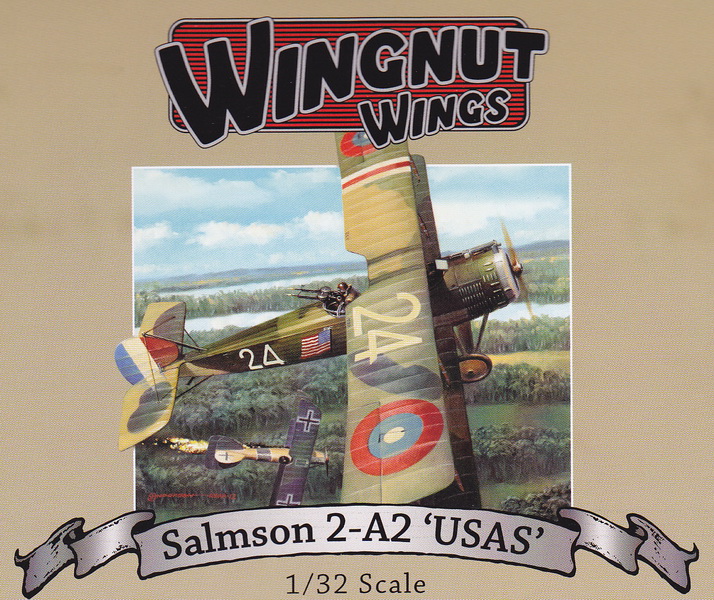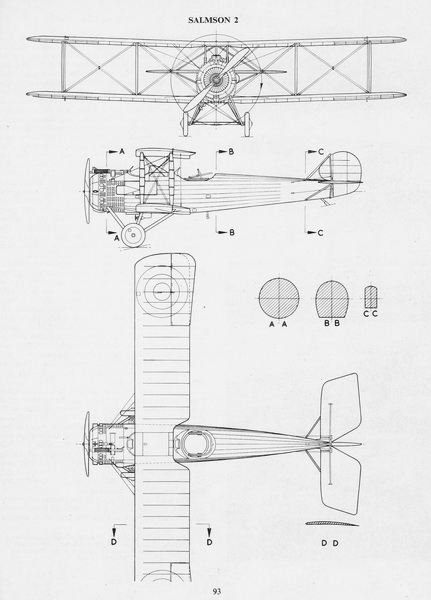|
|
HISTORICAL MINIATURES BY GEORGE GRASSE |
|
|
|
HISTORICAL MINIATURES BY GEORGE GRASSE |
|
|
SALMSON 2.A2 OF THE 12th AERO SQUADRON, U. S. AIR SERVICE, 1918 |
by George Grasse

WINGNUT WINGS 1:32 SCALE PLASTIC INJECTION MOLDED KIT WN3059 OF THE SALMSON 2.A2
|
WINGNUT WINGS WN3059 BOX ART
|
 |
|
SALMSON 2.A2 THREE-VIEW DRAWING
|
 |
| This 3-view drawing is credited to J. D. Carrick or F. Yeoman and appeared in Reconnaissance & Bomber Aircraft of the 1914-1918 War compiled by W. M. Lamberton and published by Harleyford Publications Limited. The French-designed Salmson 2.A2 two-seat reconnaissance airplane equipped five U. S. Air Service observation squadrons during America's active participation on the Western Front from April to November 1918. During that period, six USAS Salmson squadrons were active: the 1st, 12th, 24th, 88th, 90th, and 91st. The 99th and 258th became active in the last weeks of the war bringing the total to eight Salmson squadrons. |
|
THE
MODEL TO BE BUILT
|
%20Salmson%202.A2%2012th%20Aero%20Sqdn%20Photo%20(internet).jpg) |
| 'OLD CAROLINA IV' AND CREW: This photo shows Lt. Dogan H. Arthur (P) and Lt. Howard T. Fleeson (O) and the three principal mechanics of Salmson 2.A2. No. 1319 of the 12th Aero Squadron. This is possibly a post-war photo that depicts a the French national flag flying from the rear outer left wing strut. On the right wing's outer rear strut was flown a U. S. national flag. Note the makeshift wheel chock on the left front wheel. Also not how the crew and/or photographer tilted the twin Lewis guns for effect. |
%20Salmson%202.A2%2012th%20Aero%20Sqdn%20Insignia%20(Monogram%20USAS_USAAC%20pg%20189).jpg)
|
CONSTRUCTION PHOTO No. 1
|
%20Salmson%202.A2%2012th%20Aero%20Sqdn%2001.jpg) |
| FUSELAGE BEGINNINGS: This isn't much to show for the start of this build. It's the cockpit floor with a few formers. |
|
CONSTRUCTION PHOTO No.
2
|
%20Salmson%202.A2%2012th%20Aero%20Sqdn%2002.jpg) |
| FUSELAGE BASIC PAINTING: All of the colors have not been 'aged' yet. The French used 'Horizon Blue' as their protective paint for metal components. In the rear below and to the left of the antenna reel is the radio set and to its right is the battery painted in semi-gloss black. On the near side is the signaling lamp in its metal holder. Up front is the leather-covered pilot's seat, the control stick, the rudder pedals, and viewing grate. |
|
CONSTRUCTION PHOTO No.
3
|
|
|
| FUSELAGE ADDITIONS: The pilot's instrument panel bulkhead is installed and has its decals applied. Most of the formers and floor have one coat of 'aging' brown wash applied. More to follow. |
|
CONSTRUCTION PHOTO No.
5a
|
%20Salmson%202.A2%2012th%20Aero%20Sqdn%2005a.jpg) |
| COCKPIT PROGRESS - LEFT SIDE: At this stage in the sequence of construction, the fuselage framing and interior are complete. The next step is extensive internal rigging of both the structural wires and flight control wires. This construction step added the two major side components, camera (center, just past the rear cabane strut and the .303 Lewis ammunition box (four drums) attached to the third former from the rear (hanging at an angle). |
|
CONSTRUCTION PHOTO No.
5b
|
%20Salmson%202.A2%2012th%20Aero%20Sqdn%2005b.jpg) |
| COCKPIT PROGRESS - TOP VIEW: This view clearly shows the .303 Lewis stowage box. The square item in the fuselage, dead center, is the camera. |
|
CONSTRUCTION PHOTO No.
6a
|
%20Salmson%202.A2%2012th%20Aero%20Sqdn%2006a.jpg) |
| INTERNAL FUSELAGE - LEFT SIDE VIEW: The inside of the right fuselage half has been painted using Tamiya XF-57 Buff as recommended for the linen. The stringers were painted in the same color as the all of the other wood components with Vallejo 856 Ochre Brown. |
|
CONSTRUCTION PHOTO No.
6b
|
%20Salmson%202.A2%2012th%20Aero%20Sqdn%2006b.jpg) |
| INTERNAL FUSELAGE - RIGHT SIDE VIEW: The internal fuselage was rigged with .005 monofilament thread and painted in Andrea Union Blue. |
|
CONSTRUCTION PHOTO No.
7a
|
%20Salmson%202.A2%2012th%20Aero%20Sqdn%2007a.jpg) |
| ENGINE ATTACHED - LEFT SIDE VIEW |
|
CONSTRUCTION PHOTO No.
7b
|
%20Salmson%202.A2%2012th%20Aero%20Sqdn%2007b.jpg) |
| ENGINE ATTACHED - TOP VIEW |
|
CONSTRUCTION PHOTO No.
8
|
|
|
| TOP DECKING GLUED |
|
CONSTRUCTION PHOTO No.
9
|
%20Salmson%202.A2%2012th%20Aero%20Sqdn%2009.jpg) |
| LOWER WING AND TAIL UNIT IN PLACE |
|
CONSTRUCTION PHOTOS No.
10a & 10b
|
%20Salmson%202.A2%2012th%20Aero%20Sqdn%2010a.jpg)
%20Salmson%202.A2%2012th%20Aero%20Sqdn%2010b.jpg) |
| TAIL ASSEMBLY DETAILS - Note that the elevator struts are brass rod replacing the kit's plastic which seemed unstable. |